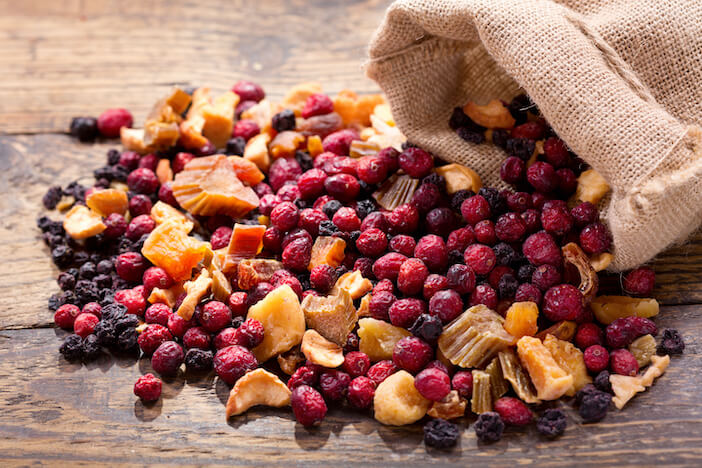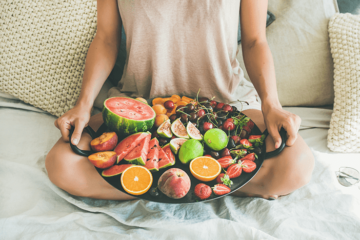Dried fruit - a healthy snack or an unexpected calorie trap?

- How are dried fruits created?
- How healthy are dried fruits?
- What varieties of dried fruits exist and which are the healthiest?
- Can you prepare dried fruit yourself?
- Are dried fruits better for you than sweets?
- Is dried fruit good for losing weight?
- Our conclusion on dried fruit
- Frequently asked questions and answers
Dried fruits are common, whether as a snack, in muesli or in a cereal bar. Dried dates, apricots, bananas and other dried fruits can be bought in the supermarkets. Many of these fruits are incredibly sweet and delicious. They are often used as a “healthy” snack alternative but are they really as healthy as you think? In this article we show that they can very quickly become an unexpected calorie trap.
How are dried fruits created?

Dried fruits are classified as fruits that have a moisture content of 18 – 25%. There are different ways of producing them. Often the fruits are dried in drying machines.
During the drying out process, the liquid is removed from the fruit by application of a great deal of heat. This has an effect on the composition and nutritional value of the fruit. A lot of vitamin C is lost during the heating process and the natural sugar content rises sharply. These processes also significantly extend the shelf life of the dried fruit.
How healthy are dried fruits?

The concentration of the dried fruit is significantly increased by the heat treatment and the removal of moisture. Dried fruits contain antioxidants, which can protect your body from carcinogens.
The high fibre content of dried fruit ensures a lasting feeling of satiety. Since quantity and volume determine the feeling of satiety, it is still better to eat fresh fruit. Compared to dried fruit, fresh fruit keeps you full longer.
The high fibre content in dried fruit can also support your digestion through its intestinal regulating effect. However, the quantity is important, because excessive consumption can have a laxative effect. Another disadvantage of dried fruit, besides the high calorie density, is the increase in sugar concentration during the drying process. Thus dried fruits quickly become an unexpected calorie trap.
What varieties of dried fruits exist and which are the healthiest?

Nowadays, there are many types of fruit available in dried form in supermarkets. The different types of dried fruit have different nutritional values. We have compared the most popular varieties and compiled their nutritional values in the table below:
Dried fruit compared to fresh fruit
| per 100g | Calories | Carbohydrates | Protein | Fats | Fibre | Vitamin C |
|---|---|---|---|---|---|---|
| Dried apples | 280 kcal | 61,0 g | 2,0 g | 2,0 g | 11,0 g | 38 mg |
| Apples | 52 kcal | 14,0 g | 0,3 g | 0,2 g | 2,4 g | 12 mg |
| Dried apricots | 241 kcal | 63,0 g | 3,4 g | 0,5 g | 7,0 g | 1 mg |
| Apricots | 45 kcal | 8,5 g | 0,9 g | 0,1 g | 1,5 g | 9 mg |
| Dried bananas | 300 kcal | 64,0 g | 3,7 g | 0,6 g | 6,4 g | 28 mg |
| Bananas | 89 kcal | 23,0 g | 1,1 g | 0,3 g | 2,6 g | 11 mg |
| Dried dates | 282 kcal | 75,0 g | 2,5 g | 0,4 g | 8,0 g | 0,4 mg |
| Dried plums | 240 kcal | 64,0 g | 2,2 g | 0,4 g | 7,0 g | 0,6 mg |
| Plums | 46 kcal | 11,0 g | 0,7 g | 0,3 g | 1,4 g | 9,5 mg |
| Raisins | 299 kcal | 79,0 g | 3,1 g | 0,5 g | 3,7 g | 2,3 mg |
| Grapes | 67 kcal | 17,0 g | 0,6 g | 0,4 g | 0,9 g | 4 mg |
Can you prepare dried fruit yourself?

Making your own dried fruit is a popular method for preserving the important nutrients and vitamins of the fruit. Apples and plums are particularly suitable for this. Various aids can be used for the drying process. It is important, however, that the moisture in the fruit gets well removed and that the fruits do not touch eachother, in order to avoid them going mouldy.
Sun and air for drying out fruit
Sun and air are a particularly effective method for drying out apples. The apples are cut into slices and hung on a string. This string should ideally be placed in a hot place. If the sun is not shining, a heater can be used instead. The drying process takes several hours until the fruit has the right consistency.
Using an oven to dry out fruit
Apples can also be dried out by baking them in the oven. Cut the apple into slices, lay out on a baking tray and put in the oven. The temperature of the oven should be around 50°C. Drying the apple slices takes at least 4 hours, but also depends on the consistency and thickness of the slices. Turn the slices 3-4 times during their baking.
Are dried fruits better for you than sweets?

Compared to traditional sweets, dried fruit is a better choice, as it provides some beneficial nutrients despite the moisture removal. However, the number of calories in dried fruit is often comparable to those in sweets (admittedly slightly lower than the calories in chocolate).
Industrial drying increases the concentration of the natural sugar content of the fruit and many vitamins are also lost. It is important to consider the amount of dried fruit you are consuming, as it contains more calories than fresh fruit and is easy to over indulge on. Dried fruit is therefore, in moderation, a possible alternative to sweets, but by no means a substitute for fresh fruit.
How much dried fruit can I consume per day?
Dried fruit can be consumed in small quantities as a snack for in-between meals. The maximum recommended portion is a handful per day. However, eating fresh fruit is still the much better choice.
Ideal are 2 portions of FRESH fruit a day!
What should you look out for when buying dried fruit?
When buying dried fruit, make sure it:
- has no preservatives
- is sulphur-free
- has no added sugar
As a general rule, the fewer ingredients the better – in this case, the only ingredient should be fruit.
Is dried fruit good for losing weight?

If your goal is to lose weight, then eating dried fruit is not advisable. The drying process makes dried fruit less filling than fresh fruit. In addition, it is easy to eat a lot of dried fruits in one sitting, as they are smaller than fresh fruit. The feeling of fullness depends on the amount of dried fruit consumed. Dried fruit has a higher energy density, so you will consume more calories than with fresh fruit. This quickly leads to an excess of calories which in turn leads to a gain in body weight. Remember, if you want to lose weight, you need a calorie deficit at the end of the day.
Our conclusion on dried fruit
Dried fruit seems to be a great alternative to sweets and fresh fruit at first. However, this statement is only partially correct and fresh fruit remains the best option as a small snack for in between normal meals.
The nutritional value of dried fruit is better than that of sweets, but one should not forget the high number of calories it contains. Ignoring that fact will quickly lead to a calorie trap.
If you don’t know exactly how many calories you are allowed to consume, then find out with our calorie calculator.
Frequently asked questions and answers
On average 100 grams of dried fruit contains 300 calories. However, different fruits have different nutritional values.
When eating dried fruit, make sure that you do not exceed the healthy amount and your calorie requirements. Dried fruit should only be used as a small supplement for in-between meals and should not be a substitute for an entire meal. You should not eat more than a handful a day.
Dried fruit often tastes very sweet compared to fresh fruit. This is because the natural fructose is concentrated and the fruit is therefore richer in calories. Some dried fruits are also additionally sweetened during the production process.



